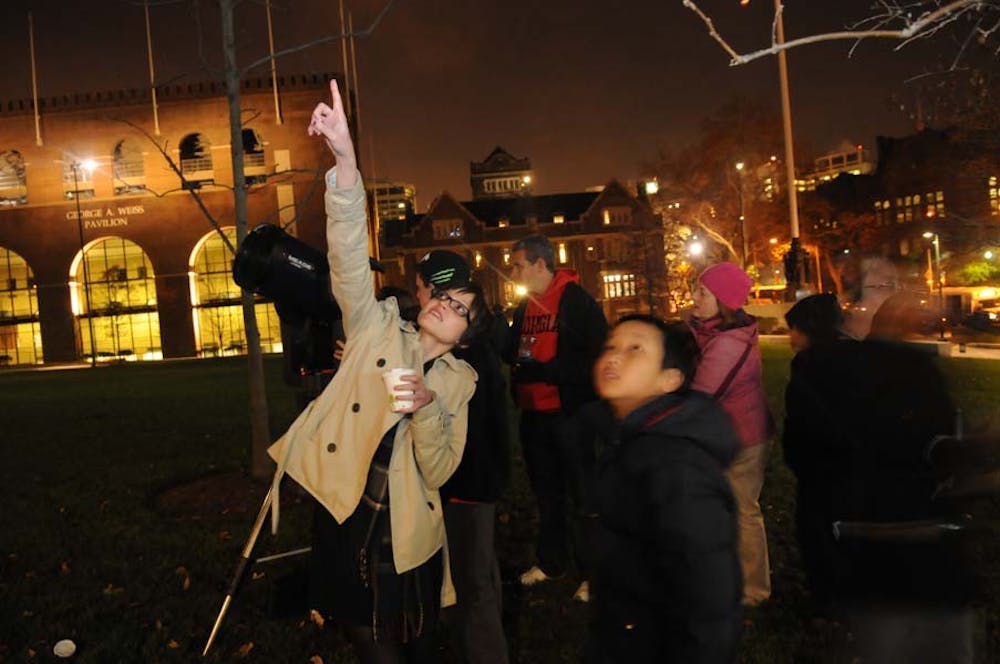Friday night, the Department of Physics and Astronomy hosted the fourth Astronomy Night on Shoemaker Green, celebrating astronomical science with the community.
The night was nippy and a bit cloudy, but there was an unmistakable community presence on Shoemaker Green. No one seemed to mind the cold or the blocking clouds, and many adults brought little kids or other friends to the event.
“This kind of thing is right up my friends’ alleys, so when I found it on the website, I knew they’d like it,” said Maria D’Arcy, a worker at the Wistar Institute.
Astronomy Night began in April 2011 as part of that year’s Philadelphia Science Festival, an event that draws over 120,000 attendees annually from all across the city. Astronomy Night is just one of many celebrations where astronomers of all scale — from the smallest stargazers to professional scientists — can explore the skies.
Last year, Penn was one of three institutions, including Drexel University and the Franklin Institute, to host a special event inviting many astronomers to its campus. Associate Director of Programs and Events for the College Juliana Walker, one of the event’s main coordinators, called it “a great success.”
However, the story of Penn astronomy and the community goes back further than this annual event. Simon Dicker, a research associate in the Department of Physics and Astronomy, has long been using the observatory in David Rittenhouse Laboratory to host small groups.
Those events became so popular that lines would stretch outside the corridor, and Dicker said that Walker then contacted him to help organize the first Astronomy Night. The organizers hosted it again last November, then once more with the Science Festival this April.
Dicker was omnipresent, constantly hopping between telescopes to replace a part or readjust its point of reference.
“I’m excited to have this new green space,” he said. “Lots more space than the observatory.” He pointed out Neptune as it set behind Levine Hall, Jupiter just above the Palestra and Uranus right above his head.
He added, “There are problems with looking through telescopes in a city. You’ve got to go to Fairmount Park or really drive an hour out to really see anything. But that’s not what this is for — this is for people who haven’t seen the moon through a telescope before.”
Inside, away from the cold and the dark, the department had set up a number of physics demonstrations to entice the crowds — gas spectra, posters on the scientists’ work, Van de Graaf generators and scale models of the solar system. Earth was represented by a peppercorn, the sun by a beach ball.
The keynote of the night was a talk by astrophysics professor Ravi Sheth. He gave a lecture on Voyager 2, the space probe soon to enter interstellar space, and discussed its history, mission and future.
There was a real sense of Sheth’s own fascination with the material, from calling gravity-assisted flight “like sinking a putt in Trieste from here” to the sheer breadth of knowledge he had about the various moons of Neptune.
He was animated, well-spoken and flexible, happy to entertain young kids’ interjections about the Big Bang and cosmic microwave radiation as he moved through the presentation. Of course, the big question of astrophysics came up — “Why is Pluto not a planet?” — but the professor obliged the question and gave a litany of answers.
“I really enjoyed the lecture,” College freshman Clara Hendrickson said. “I love learning outside the classroom, and this was a great opportunity for that.”
In closing his talk, Professor Sheth offered a quote from physics legend Erwin Schrödinger. “The task is … not so much to see what no one has yet seen,” he said, “but to think what nobody has yet thought, about that which everybody sees.”



